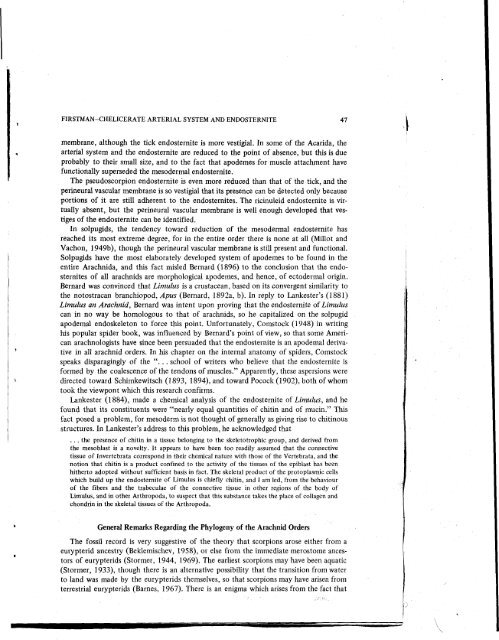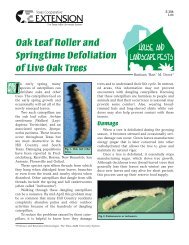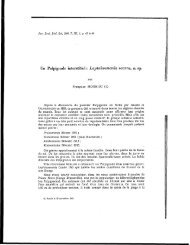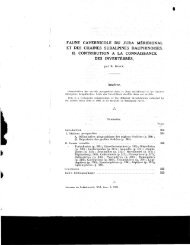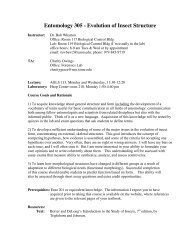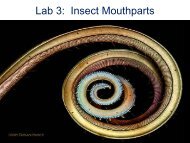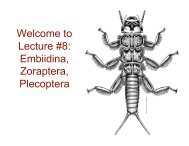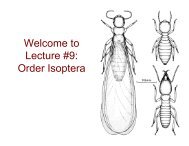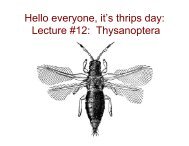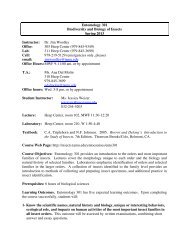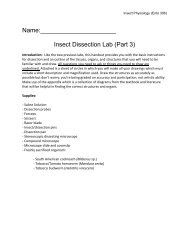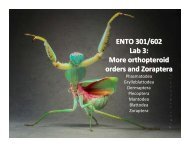THE RELATIONSHIP OF THE CHELICERATE ARTERIAL SYSTEM ...
THE RELATIONSHIP OF THE CHELICERATE ARTERIAL SYSTEM ...
THE RELATIONSHIP OF THE CHELICERATE ARTERIAL SYSTEM ...
You also want an ePaper? Increase the reach of your titles
YUMPU automatically turns print PDFs into web optimized ePapers that Google loves.
FIRSTMAN-<strong>CHELICERATE</strong> <strong>ARTERIAL</strong> <strong>SYSTEM</strong> AND ENDOSTERNITE 47membrane, although the tick endosternite is more vestigial. In some of the Acarida, thearterial System and the endosternite are reduced to the point of absence, but this is dueprobably to their small size, and to the fact that apodemes for muscle attachment havefunctionally superseded the mesodermal endosternite.The pseudoscorpion endosternite is even more reduced than that of the tick, and theperineural vascular membrane is so vestigial that its presence can be detected only becauseportions of it are still adherent to the endosternites. The ricinuleid endosternite is virtuallyabsent, but the perineural vascular membrane is well enough developed that vestigesof the endosternite can be identified.In solpugids, the tendency toward reduction of the mesodermal endosternite hasreached its most extreme degree, for in the entire Order there is none at all (Millot andVachon, 1949 ), though the perineural vascular membrane is still present and functional.Solpugids have the most elaborately developed System of apodemes to be found in theentire Arachnida, and this fact misled Bernard (1896) to the conclusion that the endosternitesof all arachnids are morphological apodemes, and hence, of ectodermal origin.Bernard was convinced that Limulus is a crustacean, based on its convergent similarity tothe notostracan branchiopod, Apus (Bernard, 1892a, b). In reply to Lankester's (1881)Limulus an Arachnid, Bernard was intent upon proving that the endosternite of Limuluscan in no way be homologous to that of arachnids, so he capitalized on the solpugidapodemal endoskeleton to force this point. Unfortunately, Comstock (1948) in writinghis populär spider book, was influenced by Bernard's point of view, so that some Americanarachnologjsts have since been persuaded that the endosternite is an apodemal derivativein all arachnid orders. In his chapter on the internal anatomy of spiders, Comstockspeaks disparagingly of the "... school of writers who believe that the endosternite isformed by the coalescence of the tendons of muscles." Apparently, these aspersions weredirected toward Schimkewitsch (1893, 1894), and toward Pocock (1902), both of whomtook the viewpont which this research confirms.Lankester (1884), made a chemical analysis of the endosternite of Limulus, and hefound that its constituents were "nearly equal quantities of chitin and of mucin." Thisfact posed a problem, for mesoderm is not thought of generally äs giving rise to chitinousstructures. In Lankester's address to this problem, he acknowledged that. . . the presence of chitin in a tissue belonging to the skeletotrophic group, and derived fromthe mesoblast is a novelty. It appears to have been too readily assumed that the connectivetissue of Invertebrata correspond in their chemical nature with those of the Vertebrata, and thenotion that chitin is a product confined to the activity of the tissues of the epiblast has beenhitherto adopted without sufficient basis in fact. The skeletal product of the protoplasmic cellswhich build up the endosternite of Limulus is chiefly chitin, and I am led, from the behaviourof the fibers and the trabeculae of the connective tissue in other regions of the body ofLimulus, and in other Arthropoda, to suspect that this substance takes the place of Collagen andchondrin in the skeletal tissues of the Arthropoda.General Remarks Regarding the Phylogeny of the Arachnid OrdersThe fossil record is very suggestive of the theory that scorpions arose either from aeurypterid ancestry (Beklemischev, 1958), or eise from the immediate merostome ancestorsof eurypterids (Stornier, 1944, 1969). The earliest scorpions may have been aquatic(Stornier, 1933), though there is an alternative possibility that the transition from waterto land was made by the eurypterids themselves, so that scorpions may have arisen fromterrestrial eurypterids (Barnes, 1967). There is an enigma which arises from the fact that


